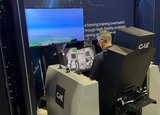I/ITSEC 2023: Can military forces solve integration issues in the training domain?
RTI is demonstrating a cockpit experience with multiple technologies at I/ITSEC 2023. (Photo: Flavia Camargos Pereira).
The need to prepare military personnel to be deployed in multi-domain missions has been requiring the use of multiple sensors and technologies in their training. In this scenario, integrating several simulation solutions, operating systems and programming languages has been a challenge for armed forces worldwide.
The issue becomes even more concerning if training capabilities are required to be deployable and to work and share data in a real-time environment.
Conducting missions with partner nations even brings additional problems. Apart from enabling the operation alongside diverse systems, the software solutions also have to provide security for sensitive information, while allowing the
Already have an account? Log in
Want to keep reading this article?
More from I/ITSEC 2023 | View all news
-
![US Marine Corps outlines next steps to improve synthetic training capabilities]()
US Marine Corps outlines next steps to improve synthetic training capabilities
The service has shown an interest in a range of training solutions from individual to battalion levels and plans to award multiple contracts ahead of new programmes set to run from FY2024 to FY2031.
-
![I/ITSEC 2023: VirTra debuts integration of VBS4 into its simulators]()
I/ITSEC 2023: VirTra debuts integration of VBS4 into its simulators
VirTra has unveiled the integration of VBS4 and BlueIG into its simulator systems with the aim of enhancing the capabilities of its technology for military training.
-
![I/ITSEC 2023: CymSTAR introduces CymLITE Series Deployable Air Refueling Trainer]()
I/ITSEC 2023: CymSTAR introduces CymLITE Series Deployable Air Refueling Trainer
The company has also used its platform at I/ITSEC 2023 to announce a new partnership with the Switzerland-based firm EDMS.
-
![I/ITSEC 2023: Guardiaris unveils the new generation of its Small Arms Mobile Trainer]()
I/ITSEC 2023: Guardiaris unveils the new generation of its Small Arms Mobile Trainer
SAMT, a laserless, plug-and-play mobile system, can incorporate small arms, anti-tank weapons, military vehicles and remote weapon stations.
-
I/ITSEC 2023: CAE unveils US Air Force digital F-16 cockpit
For the first time CAE exhibited a digital F-16 cockpit integrated with the Simulators Common Architecture Requirements and Standards (SCARS) marking a major step forward in training equipment virtualisation.
-
![I/ITSEC 2023: British Army could have saved £120 million in artillery ammunition, says manufacturer]()
I/ITSEC 2023: British Army could have saved £120 million in artillery ammunition, says manufacturer
Cubic Blue Shell, a train-as-you-fight solution, has been in use by the British Army for three years offering an indirect fire training system that simulates artillery drills and weapons effects.

























